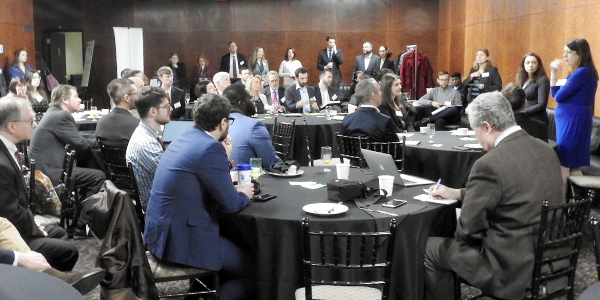By Michael Kuser
ALBANY, N.Y. — For years, the Alliance for Clean Energy New York (ACE NY) has advocated for a more standardized siting process for renewable energy projects in the state. Now it has a proposal from Gov. Andrew Cuomo to help push through the state legislature.
Getting the legislature to pass a budget amendment to create the proposed Office of Renewable Energy Permitting “certainly is our top priority,” ACE NY Director Anne Reynolds told a legislative breakfast she hosted Thursday.
Cuomo earlier in February announced the plan to amend this year’s state budget to streamline the siting process for large-scale renewable energy projects. (See Cuomo Proposes Streamlining NY’s Renewable Siting.)
The proposed budget bill aligns state law, bureaucratic practices and policies — including property tax laws — with the clean energy goals outlined in last July’s landmark Climate Leadership and Community Protection Act (CLCPA) (A8429), said Jennifer Maglienti, assistant counsel to the governor’s office.
Transmission Warranty
“Siting is a process that needed to be turned around in order to meet the goals, and the goal here was to do a soup-to-nuts rewrite, to look at not just generation, but also to deal with transmission,” Maglienti said.
To facilitate development of bulk transmission, policy planners first needed to address the timing of the Article VII process, which covers the need for a project, as well as its environmental impacts, and create automatic time frames, she said.
“What we’d like to do in the siting process is have a one-year time frame for review … and we also want to look at where are there constraints,” Maglienti said. “One large portion of the bill is to deal with how to get the DPS [Department of Public Service] along with a lot of other partners to do a comprehensive study to decide where are there constraints on the grid.”
The budget amendment calls for the DPS to work with NYISO, the state’s two power authorities and the utilities to perform a “power grid study” for the purpose of “identifying distribution upgrades, local transmission upgrades and bulk transmission investments” needed to meet the CLCPA goals.
The budget bill says the state “shall provide for timely construction of new, expanded and upgraded distribution and transmission infrastructure,” which may include “submarine transmission facilities needed to interconnect offshore renewable generation resources to the state’s transmission system.”
Anbaric and other transmission developers have argued that having individual wind farms build separate radial lines to shore will be more expensive, more environmentally intrusive and less resilient than networked, open-access facilities. (See Anbaric Pushes Offshore Grid Plans.)
“Anbaric applauds the Cuomo administration’s continued support for transmission’s essential role in reaching the state’s carbon reduction and offshore wind goals,” Theodore Paradise, Anbaric senior vice president for transmission strategy, told RTO Insider.
The CLCPA calls for 70% of New York’s electricity to come from renewable energy resources by 2030 and for electricity to be 100% carbon-free by 2040.
The law also calls for doubling distributed solar generation to 6 GW by 2025, deploying 3 GW of energy storage by 2030 and raising energy efficiency savings to 185 trillion BTU by 2025, in addition to nearly quadrupling New York’s offshore wind energy target to 9 GW by 2035.
Statutory Process
New York in 2011 revised Public Service Law Article 10 to unify siting reviews of new or modified electric generating facilities under one state agency, the Board on Electric Generation Siting and the Environment.
“Certainly Article 10 was set up for a good reason, and the processes set up for a good reason … but it’s going to be an entirely new office, and certainly with a lot of cooperation from the regulatory agencies,” Maglienti said.
The executive branch proposes that the New York State Energy Research and Development Authority will collaborate with the Department of Environmental Conservation (DEC) and DPS to develop build-ready sites for renewable energy projects.
“We want to think about how we’re going to encourage local participation, finding a way to help local communities contribute to the process,” Maglienti said. “We want the [Public Service Commission] to determine how those communities benefit, and for NYSERDA to get a site build-ready.
“When we talk about the siting of wind and solar, we’re talking in some cases about off-the-shelf technology, and we don’t need to get into long, protracted conversations about what those impacts might be and how they might be mitigated,” she said.
Community Concerns
“We met with a lot of communities and stakeholders to go through what issues people were facing when they’re trying to get more renewable energy projects sited, and we have communities who have concerns as well as developers and environmental groups who have concerns,” said Julie Tighe, president of the New York League of Conservation Voters.
Cuomo’s leadership on the siting issue is critical, Tighe said: “Having worked in the administration myself, I know that when the governor decides to do something, and he puts his mind to it, it gets done.”
DEC is well known as a conservation organization, being the largest landowner in the state of New York, and is better equipped to do siting on a regional basis, Tighe said.
“You get a much more comprehensive, regionally important project by having a mitigation bank rather than doing a one-off,” Tighe said. “We’ll probably want to see a little more specificity around that, but I think it’s a really important component and something that the legislature should advance and embrace.”
According to EPA, a mitigation bank is a wetland resource area that has been restored, established, enhanced or preserved to provide compensation for unavoidable impacts to aquatic resources permitted under Section 404 of the Clean Water Act, or a similar state or local wetland regulation.
“We very much appreciate having a process that’s just looking at renewable energy, and including transmission in that,” Tighe said.




